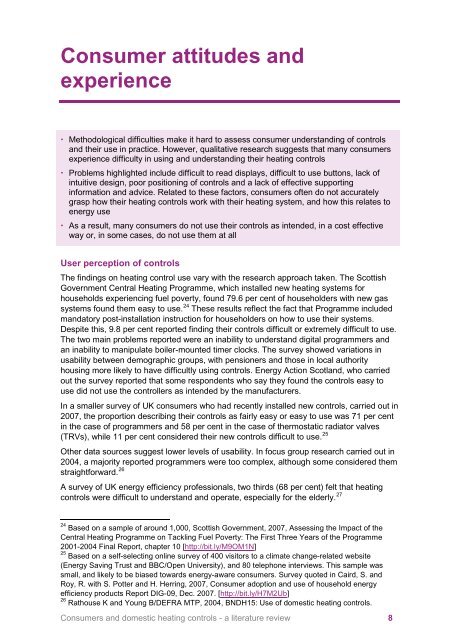Consumers-and-domestic-heating-controls-a-literature-review
Consumers-and-domestic-heating-controls-a-literature-review
Consumers-and-domestic-heating-controls-a-literature-review
Create successful ePaper yourself
Turn your PDF publications into a flip-book with our unique Google optimized e-Paper software.
Consumer attitudes <strong>and</strong><br />
experience<br />
� Methodological difficulties make it hard to assess consumer underst<strong>and</strong>ing of <strong>controls</strong><br />
<strong>and</strong> their use in practice. However, qualitative research suggests that many consumers<br />
experience difficulty in using <strong>and</strong> underst<strong>and</strong>ing their <strong>heating</strong> <strong>controls</strong><br />
� Problems highlighted include difficult to read displays, difficult to use buttons, lack of<br />
intuitive design, poor positioning of <strong>controls</strong> <strong>and</strong> a lack of effective supporting<br />
information <strong>and</strong> advice. Related to these factors, consumers often do not accurately<br />
grasp how their <strong>heating</strong> <strong>controls</strong> work with their <strong>heating</strong> system, <strong>and</strong> how this relates to<br />
energy use<br />
� As a result, many consumers do not use their <strong>controls</strong> as intended, in a cost effective<br />
way or, in some cases, do not use them at all<br />
User perception of <strong>controls</strong><br />
The findings on <strong>heating</strong> control use vary with the research approach taken. The Scottish<br />
Government Central Heating Programme, which installed new <strong>heating</strong> systems for<br />
households experiencing fuel poverty, found 79.6 per cent of householders with new gas<br />
systems found them easy to use. 24<br />
These results reflect the fact that Programme included<br />
m<strong>and</strong>atory post-installation instruction for householders on how to use their systems.<br />
Despite this, 9.8 per cent reported finding their <strong>controls</strong> difficult or extremely difficult to use.<br />
The two main problems reported were an inability to underst<strong>and</strong> digital programmers <strong>and</strong><br />
an inability to manipulate boiler-mounted timer clocks. The survey showed variations in<br />
usability between demographic groups, with pensioners <strong>and</strong> those in local authority<br />
housing more likely to have difficultly using <strong>controls</strong>. Energy Action Scotl<strong>and</strong>, who carried<br />
out the survey reported that some respondents who say they found the <strong>controls</strong> easy to<br />
use did not use the controllers as intended by the manufacturers.<br />
In a smaller survey of UK consumers who had recently installed new <strong>controls</strong>, carried out in<br />
2007, the proportion describing their <strong>controls</strong> as fairly easy or easy to use was 71 per cent<br />
in the case of programmers <strong>and</strong> 58 per cent in the case of thermostatic radiator valves<br />
25<br />
(TRVs), while 11 per cent considered their new <strong>controls</strong> difficult to use.<br />
Other data sources suggest lower levels of usability. In focus group research carried out in<br />
2004, a majority reported programmers were too complex, although some considered them<br />
26<br />
straightforward.<br />
A survey of UK energy efficiency professionals, two thirds (68 per cent) felt that <strong>heating</strong><br />
27<br />
<strong>controls</strong> were difficult to underst<strong>and</strong> <strong>and</strong> operate, especially for the elderly.<br />
24 Based on a sample of around 1,000, Scottish Government, 2007, Assessing the Impact of the<br />
Central Heating Programme on Tackling Fuel Poverty: The First Three Years of the Programme<br />
2001-2004 Final Report, chapter 10 [http://bit.ly/M9OM1N]<br />
25 Based on a self-selecting online survey of 400 visitors to a climate change-related website<br />
(Energy Saving Trust <strong>and</strong> BBC/Open University), <strong>and</strong> 80 telephone interviews. This sample was<br />
small, <strong>and</strong> likely to be biased towards energy-aware consumers. Survey quoted in Caird, S. <strong>and</strong><br />
Roy, R. with S. Potter <strong>and</strong> H. Herring, 2007, Consumer adoption <strong>and</strong> use of household energy<br />
efficiency products Report DIG-09, Dec. 2007. [http://bit.ly/H7M2Ub]<br />
26 Rathouse K <strong>and</strong> Young B/DEFRA MTP, 2004, BNDH15: Use of <strong>domestic</strong> <strong>heating</strong> <strong>controls</strong>.<br />
<strong>Consumers</strong> <strong>and</strong> <strong>domestic</strong> <strong>heating</strong> <strong>controls</strong> - a <strong>literature</strong> <strong>review</strong> 8


